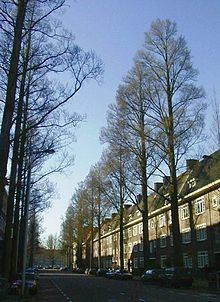Cultivar 'Sarniensis' Rank Subspecies | ||
 | ||
Similar Ulmus minor 'Goodyeri', Ulmus minor 'Stricta', Ulmus minor 'Purpurascens', Ulmus minor 'Christine, Ulmus minor 'Pendula' | ||
The Field Elm cultivar Ulmus minor 'Sarniensis', known variously as Guernsey Elm, Jersey Elm, Wheatley Elm, or Southampton Elm, once enjoyed much popularity in Britain, where it was widely cultivated for street planting. However the Dutch elm disease pandemic has now destroyed nearly all the mature trees in England save a few in Preston Park, Brighton, Bridlington, Peasholm Park, Scarborough and a single tree in Skegness. Around a hundred mature specimens still survive in Edinburgh, Scotland (2013).
Contents
The origin of the tree remains obscure; Richens believed the tree "a mutant of a French population of Field elm", noting that "elms of similar leaf-form occur in Cotentin and in northern Brittany. They vary much in habit but some have a tendency to pyramidal growth. Whether the distinctive habit first developed on the mainland or in Guernsey is uncertain." Ronald Melville believed it should be more correctly considered a hybrid between Cornish Elm U. minor 'Stricta' and Dutch Elm Ulmus × hollandica for which the botanical name would be U. × sarniensis (Loud.) Bancroft.
Its clonal origin is (to date) suspected rather than proved, but the apparent uniformity of this taxon makes it likely to be a clone. Arguing in a 2002 paper that there was no clear distinction between species and subspecies, and suggesting that known or suspected clones of U. minor, once cultivated and named, should be treated as cultivars, Dr Max Coleman of Royal Botanic Garden Edinburgh preferred the designation U. minor 'Sarniensis'.
Description
The tree has a compact, columnar form, not dissimilar to the Lombardy Poplar. Rarely exceeding a height of 27 m, the tree has long stiff ascending branches forming a narrow pyramidal crown. Older specimens broaden round the 'waist', giving trees with a tapering crown a Chianti-flask shape. Like Cornish elm, a narrow-crowned elm from the same area, Guernsey elm is one of the last British trees to come into leaf, and it retains its dark, lustrous foliage into early winter. In favourable conditions it turns a rich golden-yellow in late November or early December. The small leaves and samarae are similar to those of the Field Elm group in general and of the Cornish elm in particular. Like others of the group, the tree suckers very freely. The tree often develops highly distinctive cancerous burrs on its branches or trunk.
Pests and diseases
The Guernsey Elm is very susceptible to Dutch elm disease.
Cultivation
The Guernsey Elm, reported in 1815 to be "confined to Guernsey", was in English nurserymen's catalogues by the 1830s. With its light, upcurving branches it never became a danger, unlike English elm, which sometimes shed heavy lateral boughs. This fact, and its compact form, made it ideal for street planting. It was introduced to Osborne House on the Isle of Wight by Albert the Prince Consort, where it survives today as suckers along the lane leading to Barton Manor Farm. Guernsey Elm was also planted in large numbers across Amsterdam, but eventually replaced by the similarly fastigiate but much more disease-resistant clone, 'Columella' [1].
The tree appears to have been introduced to the USA, featuring in the 1904 catalogue of Frederick W. Kelsey as Ulmus Wheatlyi and also the catalogue of the Plumfield Nursery of Fremont, Nebraska, in 1934, its origin claimed as Holland, the description given as 'a round-headed tree with small glossy leaves....hybridized with American White Elm' (:U. americana), which would seem unlikely given the ploidy differences.
Notable trees
Among the largest surviving specimens of Guernsey Elm in the UK are two in Warriston Cemetery, Edinburgh (2013), bole-girth 3 m, and the one in Preston Park, Brighton. The latter is 34 m tall with a trunk 115 cm d.b.h. (diameter at breast height) in 2006, part of a line of trees averaging 30 m in height planted circa 1880. The tallest on record in the UK stands on Paradise Drive, Eastbourne and had a height of 36 m in 2007.
Etymology
The tree is named for the Channel Island of Guernsey (Sarnia is the Ancient Roman name for Guernsey), whence it may have originated. A similar tree is found along the Brittany coast, referred to in several 18th and 19th century French treatises as 'l'Orme male' owing to its phallic resemblance and it is still sometimes referred to as the Male Elm in Guernsey, although no mature trees survive there either. The synonym Wheatley Elm was derived from a tree planted at Wheatley Park, Doncaster, whither it was introduced and propagated by Sir William Cooke in the early 19th century. The tree was also raised in great numbers at the Rogers nursery in Southampton in the late 1800s, which probably explains the synonym Southampton Elm. Although the tree is also known as the Jersey Elm, its introduction from Guernsey has been clearly chronicled.
Accessions
Nurseries
None known.
